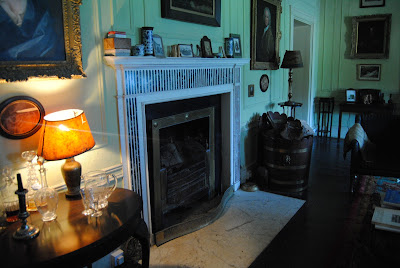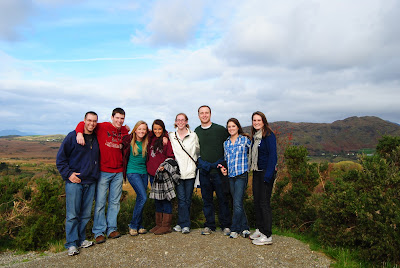For the ‘History and Culture of Modern Ireland’ course that I am enrolled in, we’re able to go on field trips to supplement the things that we have been learning in class. In the first few weeks, we covered a lot of information surrounding plantations, estates and cottages, and the potato famine and this trip gave a face to the things we were just hearing about in class.
On Wednesday the 20th, we all boarded a bus at 8:45. Leaving by 9:00, the 21 American students enrolled in this class were on the way to the west! We drove for a couple hours and made our first stop at the Strokestown estate. The Strokestown estate was home to the Mahon family since it was built. The estate operated much like the feudal system used to- the ‘landlords’ lived in a big house inside a gated area of property that their family lived on. On the outside of these walls were smaller plots that were rented by the peasants who lived on the property and farmed their own food/raised their own animals. We got a guided tour of this house, which is one of the oldest of it’s kind and also one of the most well preserved. The tour guide gave us a pretty comprehensive history of the family as well. Here are some photos from the estate:
After we finished this tour, we were able to browse through the Famine Museum, which was on the same property. Western Ireland was hit the hardest by “An Gorta More” (The Great Hunger), so it was really interesting to see artifacts and read about exactly how the people of western Ireland dealt with the famine.
After we had a quick lunch of soup and bread, we boarded the bus again and were on our way to the Museum of Country Life. Living in Dublin, you get a completely different view of how things have grown and developed over the years because it’s a city atmosphere. The teachers of our class thought it was important for us to be exposed of all aspects of Irish life- hence the museum. Walking around and seeing some of the rituals that took place, tools that were used, and materials that were made was really cool. Here’s a few highlights:
After this, we drove about an hour and finally arrived in Westport, where we would be staying for the three nights. We wandered around the little town for a while as we waited for dinner to be served, exploring little shops and nooks and crannies of a town vastly different from Dublin. We were served a full three course meal at the hotel (delicious!) and then got dressed and headed out to a few local pubs that were hosting live music. Matt Molloy’s was our first stop. He is a member of The Cheiftains and has much popularity both in Ireland and throughout the world. There are actually 2 Grammy’s that he won sitting behind the bar! The live music here was awesome- a cool setting too, because the guys who were playing were just sitting in the corner of the bar in a circle doing their thing. Actually at one point, an older Irish guy pulled me up into the middle of the floor and started to try to teach me ‘how to jig.’ I’m not sure how successful I was, but it was a funny experience! Then, we went over to the bar next door, The Porterhouse. There was live music here too and a really cool atmosphere so it was a lot of fun.
On Thursday morning, we were up and out by 9:30. Our first stop was Croagh Patrick, a mountain said to be where St. Patrick sat on the summit and fasted for 40 days in the fifth century. We were only able to climb up a small distance to a checkpoint because we had a lot more to do in our day. It was gorgeous though!
We walked across the street from Croagh Patrick to see the National Famine Memorial too. As I said, western Ireland, especially County Mayo (where we were) was hit particularly hard when the Potato Famine struck, so there is a monument to commemorate the famine here. The monument is an artistic replica of a coffin ship which is a ship that was used to carry peasants away from Ireland during the time of hunger that usually lost about 40-50% of the members on board by the time they reached their destination. The sails are made of skeletons as well, to represent the amount of lives lost.
After we left the National Famine Memorial, we got back on the bus and drove to our next destination. On our way, we drove through the ‘Famine Road.’ This was a path taken by thousands of peasants as they sought refuge and food from the rulers of the time. The views were absolutely breathtaking.
After this, we made our way to Connemara National Park where we were able to hike for a few hours. Our group did the medium loop around the park because the highest/longest one required more time than we were allotted. Here are some photos from that too!
After the hike, we got back on the bus and headed back to the hotel in Westport. Again, we had a lovely 3 course meal from the hotel and went out into the town for the night.
On Friday morning, our first stop was to Tom Hannigan’s house. Tom comes from a family of peasants who lived on an estate for most of their life. He has preserved the cottage that his family has owned for centuries perfectly, and uses it as a way to explain the way of life of the peasant. We’d already seen how it works in the estates, so this was a cool way to get both sides of the story.
We didn’t really have great weather for the day, but we went on to our next destination anyway. Achill island is a small island off of the West Coast, and we went on the Atlantic drive along the coast. We did stop to get out a few times, but the rain was pretty fierce so mostly it was just views from the bus!
Dinner that night- and then we went out on the town for our last night in Westport! Cosy Joes, a local bar/club, was having a 2.50 euro drink promotion all night, so I’d say that was a success J We took the bus home to Dublin in the morning and were back by about 1pm!





























No comments:
Post a Comment